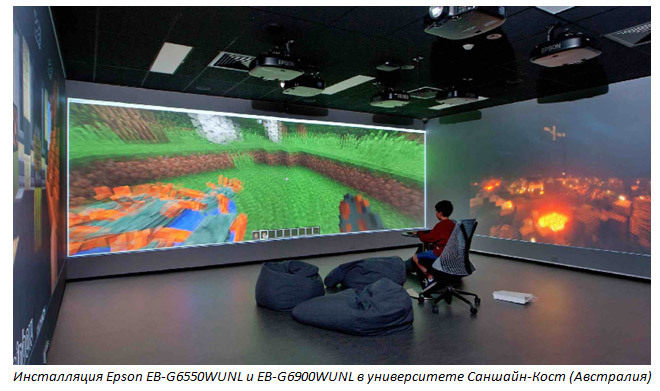Epson installation projectors world guide - EPSON Projector User Case Study

Projectors for offices and meeting rooms, classrooms and auditoriums, living rooms and home theaters - as a rule, they all have a luminous flux of up to 3,500 lumens. For most tasks this is more than enough. But it is necessary to aim a big room - you will need a larger screen, and the standard brightness will not be enough, because with an increase in the width and height of the screen twice, the requirements for brightness, as well as the screen area, will increase by four .
5000 lumens - the maximum level of brightness, which reach compact projectors. For example, Epson projectors of the Epson EB-19xx series, such as the Epson EB-1975 - weight less than 5 kg with the case width of 38 cm, can be attributed to rather compact models.
Above 5,000 lumens is a fundamentally different class of devices, such as professional installation projectors .
On these projectors, examples of impressive installations with their use, and on the EPSON Projector User Case Study mobile application today and tell.

Projectors and their features
Epson has three main lines of installation projectors: EB-4000 series, EB-G series (so-called “G'ki” , brightness up to 7000 lumens) and EB-Z series ( “Z'ki” , up to 11000 lumens) . In addition, a model based on a laser light source with a brightness of 25,000 lumens ( EB-L25000U ) is planned for this fall, and the EB-L1000 laser installation projectors with a brightness of up to 12,000 lumens are on sale now. About laser projectors will tell in the next post on the topic.
What are the possibilities of Epson installation projectors, and what level of projects can we implement on the basis of our equipment?
EPSON Projector User Case Study
The EPSON Projector User Case Study application (currently available only for iOS) will help answer these questions.
')

It contains photos, videos and descriptions of interesting projects implemented throughout the world. The projects on display are related to a wide range of areas: education, corporate sector, museums, entertainment ... All implemented projects used Epson installation projectors of the EB-4000, EB-G and EB-Z series, and the tasks could be completely trivial - projecting on a big screen and quite specific, including complex crosslinking of images projected on the curved surface, the creation of screens in the form of a dome projection and observation of 360 degrees, as well as video mapping and creating 3D-bright image on a large scr no. At the same time, projectors were installed under a wide range of inclinations — they were projected onto the ceiling, onto the floor, and in portrait mode.

Using the application is simple - the main menu displays a list of all projects and areas of activity to which each belongs. By selecting a project, you can see the available photos and images, as well as a brief description of the project (you can get there from the photos of the project by scrolling down the screen).
The selection of cases gives the impression that there are no such tasks that Epson installation projectors could not cope with. Actually, we all recommend that everyone interested in the capabilities of Epson installation projectors be familiarized with anyone who has decided to implement something similar for his own purposes.

A few words about technology
At the end, I would like to once again return to the technologies: Epson projectors based on 3LCD technology traditionally have an advantage over single-matrix models for “fair” maximum brightness, which is also called “ color brightness ”. High color brightness, equal to the maximum brightness of the projector, is a mandatory sign that the projector is really capable of producing a high-quality color image at the maximum declared brightness. This was told in one of our posts .
By the way, the newest generation of installation projectors of the Epson EB-L1000 series can boast that not only dies, but also phosphors are made from inorganic materials . This is a rarity on the market and has already allowed to extend the official warranty on laser projectors (in its entirety, not just the light source) to 5 years or 20,000 hours of work! In addition, how not to mention significantly increased native contrast and excellent color accuracy of these models. We will tell you more about them very soon!
In addition, the latest G- and L-series projectors with WUXGA resolution are capable of receiving 4K signals and displaying them using 4K Enhancement technology. The same technology can be used in conjunction with the “Super Resolution” function when displaying standard 1080p content, significantly reducing the visibility of the pixel grid and providing improved detail.
Source: https://habr.com/ru/post/396897/
All Articles